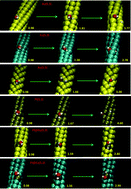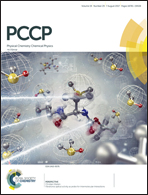Prediction of metallic nanotube reactivity for H2O activation
Abstract
The reactivity of metallic nanotubes toward the catalysis of water dissociation, a key step in the water gas shift reaction (WGSR), was analyzed through density functional theory (DFT) calculations. Water dissociation was studied on surfaces of nanotubes based on copper, gold and platinum, and also on platinum doped copper and gold nanotubes. Gold and copper nanotubes present activities that are similar to those of their corresponding extended surfaces but, in the case of the Pt(5,3) nanotube, a significant improvement in the activity is found when compared with the extended surfaces. In fact, the calculations predict the water dissociation to be spontaneous on Pt(5,3) with a low activation energy barrier. The platinum doping of gold and copper nanotubes leads to contrasting effects, i.e., with a slight increase of activity found on gold and a slight decrease of activity in the case of copper. The consideration of a Brönsted–Evans–Polanyi (BEP) relationship to estimate the activation energy barriers for the O–H bond break leads to a satisfactory agreement between estimated and explicitly calculated values which suggests the validity of the BEP relationship for qualitative predictions of the activities of metal nanotubes towards the water dissociation reaction.



 Please wait while we load your content...
Please wait while we load your content...